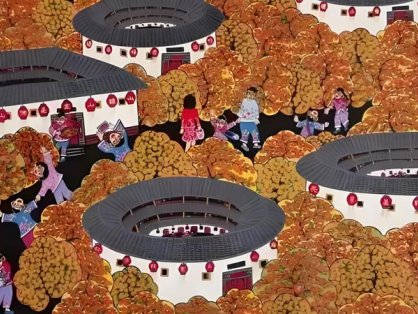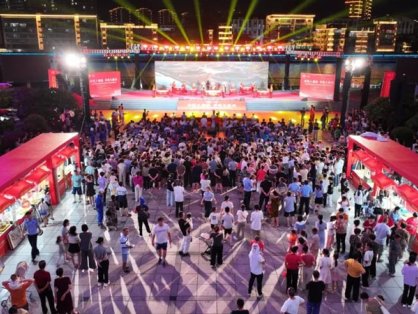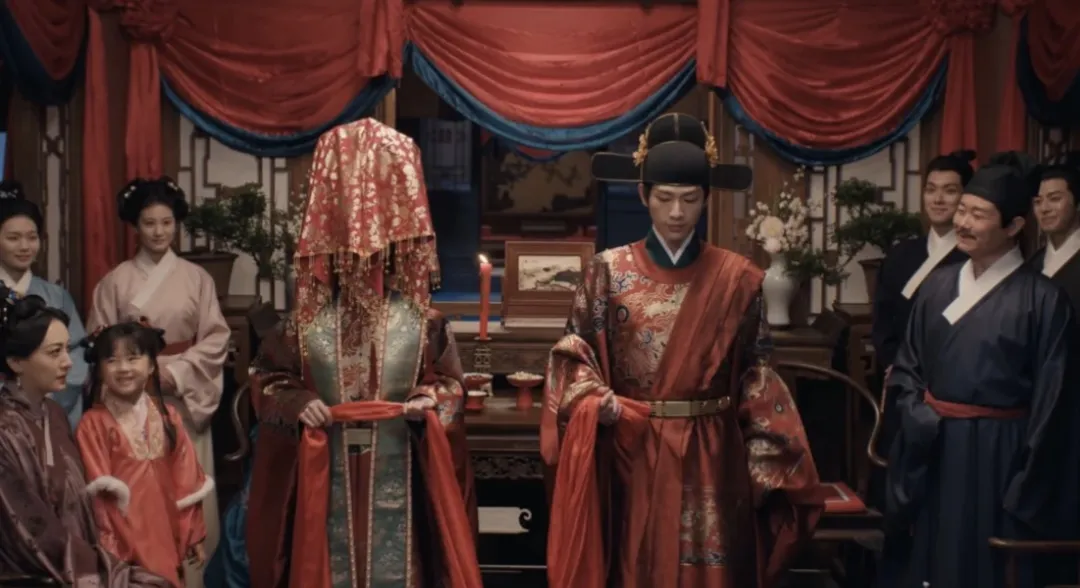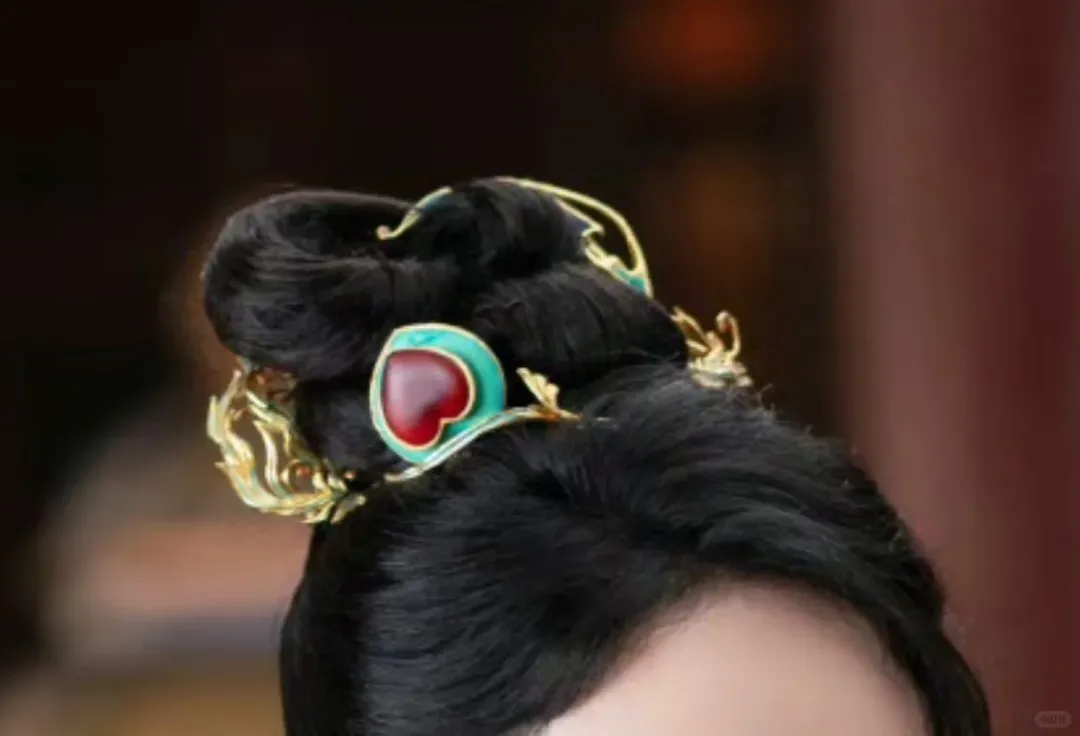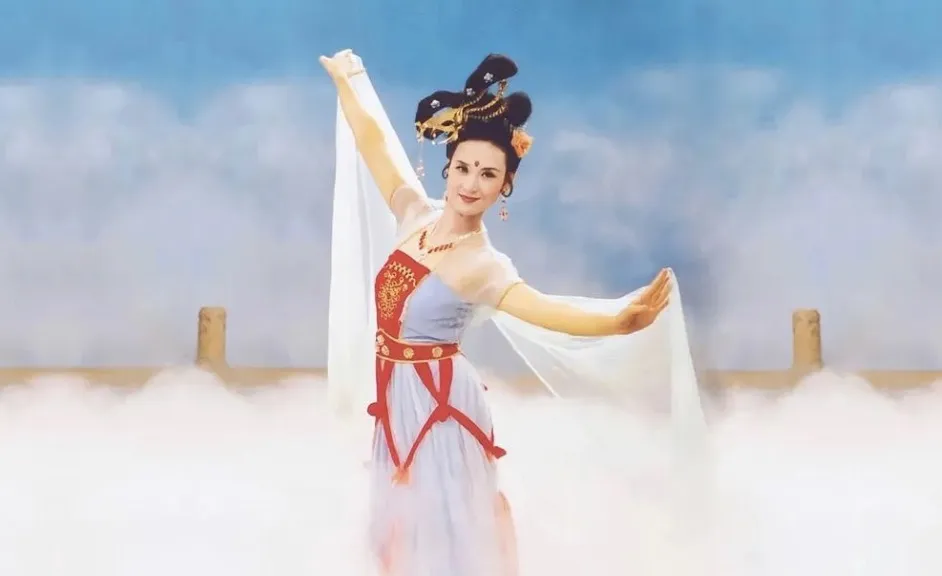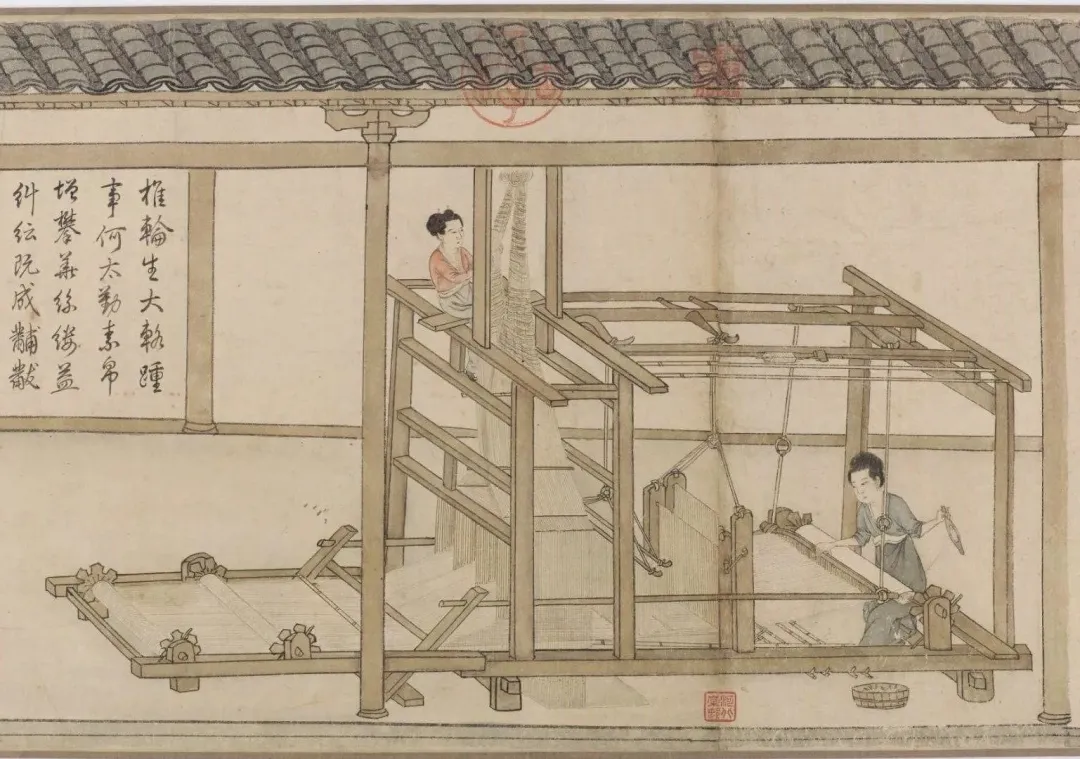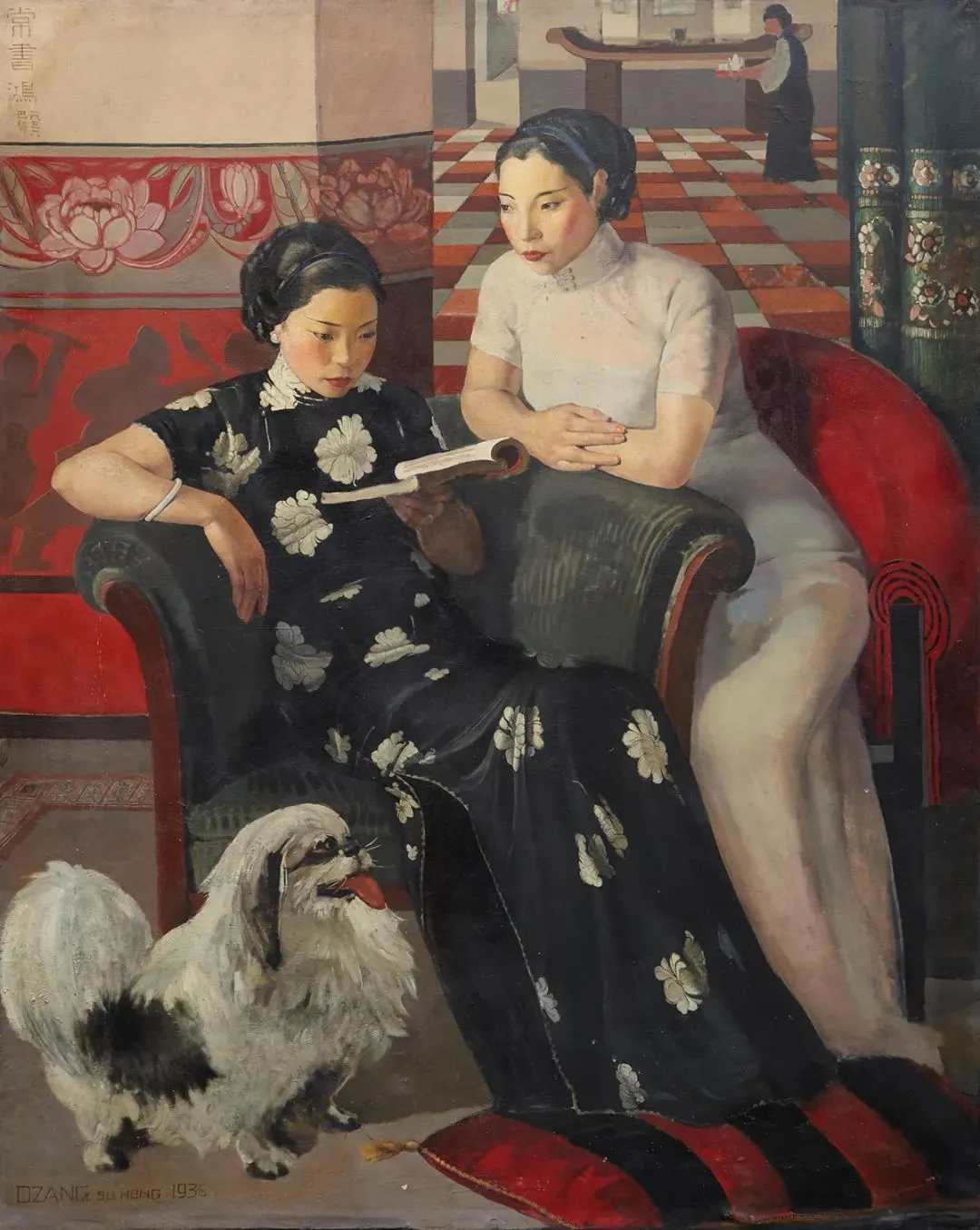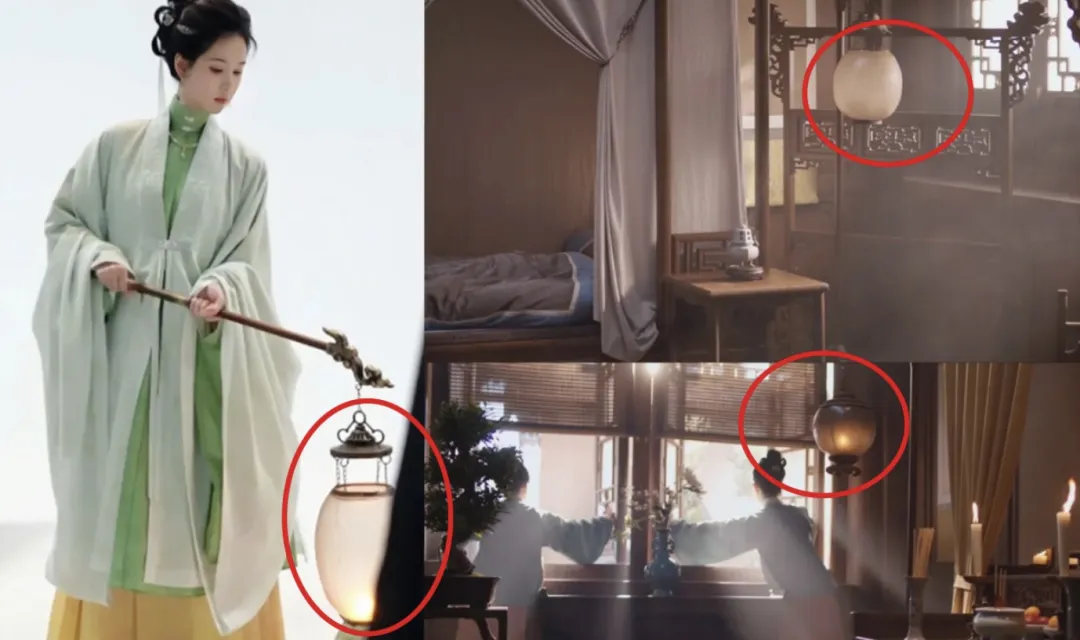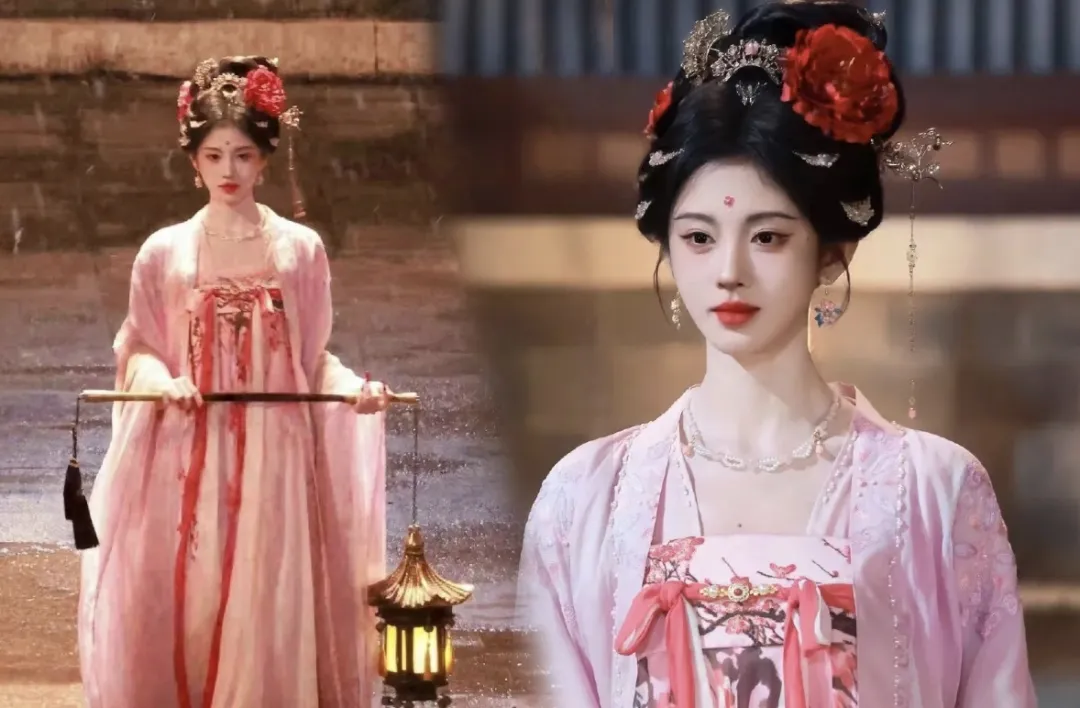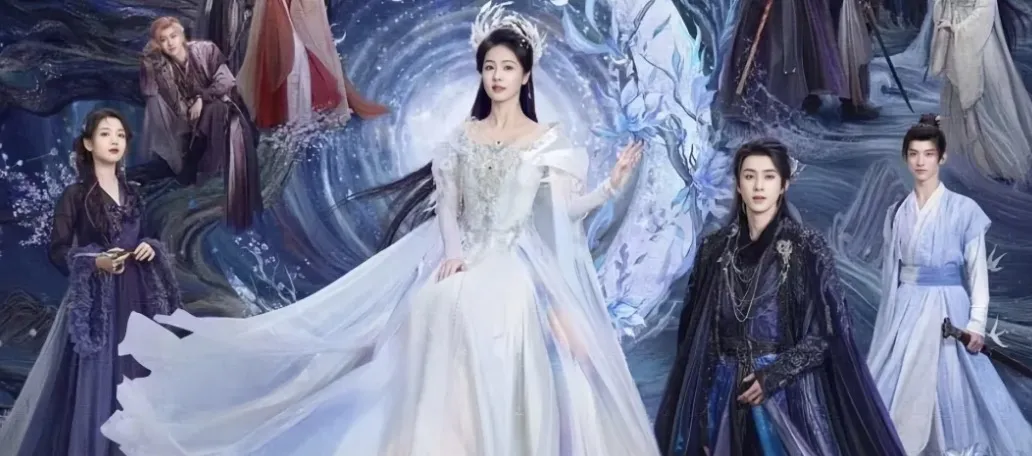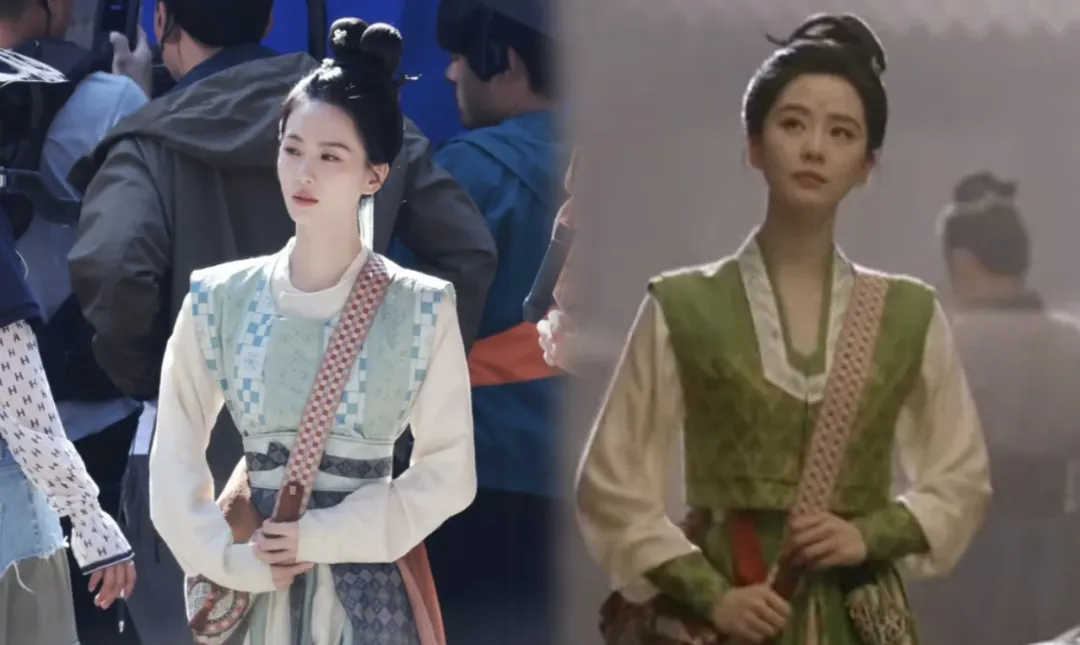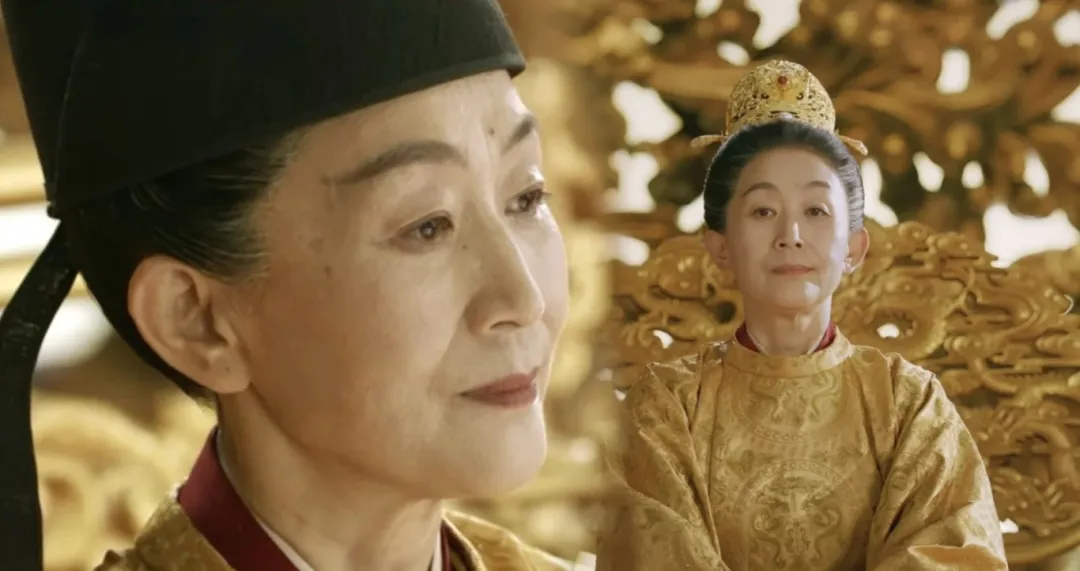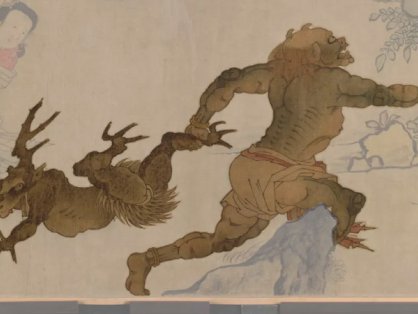-
Vibrant Strokes: The Rebirth of Zhangping Folk Art
When the monumental folk painting Fujian’s Jubilant Song (3.23m × 2.51m) debuted at China’s inaugural Rural Art Exhibition, its crimson hues and dynamic scenes—from ancient Tulou buildings to lion dances—captured the essence of Fujian’s spirit. Created by seven artists from Zhangping, this work symbolizes the revival of a 400-year-old tradition nearly lost to urbanization. Wu Yuhuan (吴玉环), a master painter, describes the style: "Bold colors, whimsical figures, and auspicious themes that radiate sincerity." Once fading, Zhangping’s folk art now thrives through innovation and community effort. Roots in Resilience Zhangping’s painting legacy began in Xin’qiao Township during the Ming-Qing transition. Local artisans blended folk customs with daily life observations, developing a distinct aesthetic recognized as Fujian’s intangible cultural heritage. By the 1980s, "The Zhangping Phenomenon" emerged—a golden era where artists won national awards for works bursting with rural vitality. Yet by the 2000s, economic pressures drove painters toward commercial replica art. Chen Yongfeng (陈永凤), director of Zhangping Art Museum, recalls, "The exodus left villages silent. We feared the tradition would vanish." The 2010 founding of Zhangping Folk Painting Academy reversed this decline. Veteran artists like Wu Yuhuan and Liu Wenying (刘文英) led free workshops, attracting teachers, farmers, and artisans. Lan Yanping,…- 0
- 0
- 9
-
Nanjing Intangible Cultural Carnival, Peace and Dragon Art
Summer in Fujian's misty mountains ignites with living traditions. Nanjing County, guardian of UNESCO-listed earthen Tulou fortresses, recently launched its inaugural Intangible Cultural Heritage Carnival alongside a vibrant summer tourism season. This fusion of ancient craftsmanship and contemporary celebration transforms historical sites into dynamic cultural hubs, where drumbeats resonate through centuries-old walls and artisanship breaks world records. The carnival isn't merely a festival; it's a testament to a community breathing new life into ancestral wisdom while forging global connections. Igniting the Cultural Flame The carnival commenced on July 4th at Nanjing Cultural Center, illuminated by projections showcasing the region’s emerald landscapes and intricate Tulou architecture. Provincial leaders, heritage scholars like Dr. Han Jie from Xiamen University, and guardians of fading crafts gathered as thunderous drum performances in Tulou Gu Yun: Welcoming Guests (土楼鼓韵▪迎客来) shook the auditorium. The rhythmic pulse embodied both reverence for the past and excitement for new beginnings. A highlight emerged with the unveiling of The Art of Tulou Construction (土楼营造技艺), a seminal book preserving vernacular building techniques nearly lost to time. Its release, alongside a documentary chronicling 100 Tulou structures, marked a milestone in scholarly preservation. When officials activated the carnival by pushing ceremonial rods, they symbolically…- 0
- 0
- 8
-
Why Did the Ancients Prefer to Hold Weddings at Night?
Nowadays, many people hold their weddings at noon, and some even insist on finishing before 12:00. However, in ancient times, weddings were usually held at night, and this is often shown in well - made ancient costume dramas. Is there any special significance that we don't know? When faced with such questions, many people around us may be informed that weddings were formerly called "hun li" (昏礼). Since ancient people often held weddings at dusk, it was named so. But this seems to just replace one conclusion with another, without explaining why weddings were held at dusk or close to night. Let me state the conclusion first. There are two main reasons for holding weddings at night: one is related to the theory of yin and yang and the five elements; the other is the evolution of the custom of bride - abduction. Now let's elaborate. The Theory of Yin and Yang and the Five Elements Since men belong to yang and women belong to yin, the intersection of yin and yang is "hun" (昏). According to "The Book of Rites", "A man takes a wife at dusk. Since a woman belongs to yin, it is called 'hun' (marriage)." Here,…- 0
- 0
- 19
-
Ancestors Showed a Heart from 3,000 Years Ago
In the cdrama "Huai Shui Zhu Ting (淮水竹亭)", Wang Quanhongye, played by Zhang Yunlong, created a 'heart' for Huai Zhu, played by Liu Shishi. Netizens wondered: Did we have heart - shaped patterns before? I thought they only emerged in modern times. Let me state the conclusion first. As a symbol of love, many believe that the use of heart - shaped patterns on utensils, fabrics, and decorations was introduced into China from the West in modern times. However, this romantic symbol isn't exclusive to the West. The East had its own 'heart - shape' long ago, and it was quite prevalent! As early as in the oracle bone inscriptions unearthed from the Yin Ruins, we found the earliest Chinese character for 'heart'. This indicates that the heart - shape has a long history in China. Through decorative art, more people have a bit of reverie about this kind of romance. Regarding the origin of the character 'heart', there are two main views in the academic circle: one is that it originated from the scene of holding a heart with both hands during sacrifices; the other is that the character 'heart' is a simple pictograph. In 'Shuowen Jiezi', 'heart' is…- 0
- 0
- 8
-
What's the Real Costumes of Chinese Immortals?
Why were the immortals in ancient costume dramas easily distinguishable at a glance? In today's Xianxia (仙侠) - themed movies and TV shows, the image of immortals usually features white, long robes fluttering in the wind, along with a combination of Chinese and Western photo - studio styles. So, which one is the "real immortal"? Let me state the conclusion first. The images in old - fashioned TV shows were mostly modeled after the traditional costumes in immortal paintings, rather than being conjured up out of thin air. In contrast, modern Xianxia dramas adopt a uniform white color scheme and loose - hair makeup due to modern minimalist aesthetics, which has created a stereotypical impression of Xianxia among most young people. However, can we just make wild guesses about immortal costumes without a dynasty background? No. Looking at the Xianxia dramas in recent years, there are those with ancient Chinese styles, Western styles, or a blend of both. But without exception, pure white and light - colored outfits dominate. No wonder fans say, "To look charming, wear all white." When we examine ancient murals, we find that the immortals' clothing was colorful. The ancients also painted immortals, and like us…- 0
- 0
- 6
-
Song Brocade, the Top Fabric of Cheongsam
Song Brocade. As one of China's traditional silk handicrafts, Song Brocade traces its origins to the Spring and Autumn period, took shape during the Song Dynasty, and flourished in the Ming and Qing Dynasties. Alongside Nanjing Yun Brocade, Sichuan Shu Brocade, and Guangxi Zhuang Brocade, it is revered as one of China's Four Great Brocades. Historical records from the 'Song Shi Yu Fu Zhi' note that after the Southern Song court relocated south, the urgent demand for high - quality brocade for calligraphy, painting mounting, and clothing production made Suzhou the primary production hub. Hence, later generations invariably associate brocade with Song. The documentary 'The Splendid Tale' highlights how Suzhou's unique geographical advantages and abundant resources provided superior raw materials, earning Song Brocade the moniker 'Suzhou Song Brocade.' The local folk song 'Wu Ge' captures the regional essence: 'In April, the warmth spreads, and households bustle with silkworm rearing.' The 'Silk Weaving Illustrated' by Southern Song painter Lou Shu offers a glimpse into the entire production process from'silkworm bathing' to'silk weaving.' After its zenith during the Yuan, Ming, and Qing Dynasties, Song Brocade perfected its technique, featuring warp - faced twill as the base and weft - faced twill for…- 0
- 0
- 16
-
When Painters Meet Qipao: A Collision of Arts
Qipao, with its profound cultural heritage and sartorial charm, has served as a unique muse for countless artists, inspiring diverse expressions and creations. Today, I'd like to explore the different charms and beauty of Qipao as depicted in paintings. Xu Beihong, a foundational figure in modern Chinese art, was one of the most influential painters in 20th - century China. He pioneered the introduction of Western realism into Chinese painting, blending the 'linear modeling' of Chinese art with Western 'light and shadow structures,' innovating without losing essence. His oil painting 'Portrait of Miss Jenny' is widely regarded as his best work in terms of color. Painted in 1939 at the request of the Belgian Vice - Consul in Singapore, it depicts Miss Jenny in a light - toned, figure - hugging Qipao. The satin's fluidity and the floral print are enhanced by impressionistic touches. Behind this masterpiece, Xu showed his dedication to supporting the anti - Japanese war effort. He often exhibited his works in Southeast Asia to raise funds for war orphans. Portrait of Sun Duoci This portrait depicts Xu's student, Sun Duoci, in an ink - wash - style printed Qipao. The side slit highlights her legs, and…- 0
- 0
- 19
-
Why Are There So Many White Lanterns in Cdramas?
Why are there so many white lanterns in dramas like Yan Hui Shi, which references Ming Dynasty costumes? Even during festivals, white lanterns dominate. Isn't it considered unlucky to hang white lanterns at home? Let’s start with the conclusion. In traditional Chinese lantern culture, lanterns come in various colors, and white lanterns are one of them. Many ancient paintings depict white lanterns used in celebrations and rituals. People believed that lighting white lanterns at night could dispel darkness and convey blessings and good wishes. During festivals, households would hang white lanterns to express hopes for future happiness and prosperity. In daily life, white lanterns were also used for illumination, while other colored lanterns served as decorative accents. When lit, white lanterns emit a soft yellow glow, making them a common sight in ancient paintings. In Ming Dynasty-inspired dramas, aside from geometric-shaped lanterns (square, round, triangular) or those resembling animals and objects, we also see unique designs like horn lanterns, crimson gauze lanterns, and boneless lanterns. Among these, horn lanterns are one type of 'white lanterns' we often see. Similar lanterns include those made from sheep horn or the more expensive rhinoceros horn. Though they appear white, they are closer to…- 0
- 0
- 19
-
Her Cheongsam Girls Are Internationally Renowned!
Women understand women best. The cheongsam girls in her paintings are well - known internationally! The second installment of the cheongsam series by the artist has arrived. In the previous issue, we mainly talked about the female cheongsam moments painted by male painters. Today, let's discuss how female painters shape female beauty, and what different perspectives and presentations they have from male aesthetics. The painter we're going to talk about today has a special background and an amazing story. Her name is Pan Yuliang (潘玉良). Born on June 14, 1895, in Yangzhou, Jiangsu, and from Tongcheng, Anhui, formerly named Chen Xiuqing and also known as Zhang Yuliang, with the courtesy name Shixiu, she is a modern Chinese painter, sculptor, and art educator. Dramatic Life Before talking about her works, let's briefly learn about Pan Yuliang's story. She was born into a very poor family in Yangzhou. She lost her father at one year old, her sister at two, and her mother when she was eight. An eight - year - old girl faced the problem of survival. Orphaned Pan Yuliang was first adopted by her uncle. Unfortunately, at the age of 13, her gambling - addicted uncle sold her to…- 0
- 0
- 45
-
Ju Jingyi and Chen Duling's Floral Hairpin Styles
Recent behind - the - scenes photos from the film set featuring Ju Jingyi and Chen Duling’s floral hairpin styles have sparked heated discussions online. Some netizens pointed out that Chen’s look appears "overwhelmed by oversized flowers and a smaller head," creating a disproportional effect, while Ju’s styling aligns more closely with traditional aesthetics. Analysis reveals that these differences stem from distinct interpretations of Tang Dynasty floral adornment culture: Chen Duling’s Historical Inspiration Her hairstyle draws from the "high coiled bun" (峨髻, é jì) depicted in Zhou Fang’s iconic painting Court Ladies Adorning Their Hair with Flowers (簪花仕女图). Historically, such buns required a height of 28 - 29 cm (Tang Dynasty measurement) to balance the visual weight of the floral ornaments. Modern adaptations often retain actors’ natural eyebrows rather than recreating the Tang practice of shaving and redrawing them, and today’s slimmer facial features make it challenging to replicate the original proportions. Netizens improved the balance by digitally raising the bun’s height and adding U - shaped hairpins for lateral symmetry. Ju Jingyi’s Styling Approach Her look adopts a classic Tang - Song era updo, featuring a center - parted front and a coiled top bun to elongate the silhouette…- 0
- 0
- 48
-
Why Do Immortals in TV Shows Always Wear White?
In fantasy-themed TV dramas, immortals are often depicted wearing pristine white robes that flutter in the wind, sometimes blending Eastern and Western styles. But is this historically accurate? While modern interpretations mix ancient Chinese aesthetics with European influences, the dominance of white or light-colored costumes has led to the saying: Elegance comes from simplicity. However, a closer look at ancient murals reveals a far more colorful wardrobe for these celestial beings. Historically, immortal attire drew inspiration from real-life clothing of specific dynasties, adorned with intricate accessories. For example, Dunhuang murals heavily influenced the costumes in The Long Ballad, incorporating Buddhist-inspired designs and vibrant color palettes. Authentic Chinese immortal garments trace their roots to Taoist art, such as Gu Kaizhi's Nymph of the Luo River or Wu Daozi's Eighty-Seven Immortals. The Chaoyuan Tu murals in Yongle Palace showcase lavish robes with wide sleeves, adorned with jade pendants and ornate headpieces—far removed from today's minimalist portrayals. These outfits followed Hanfu's foundational structure, layered with accessories like feathered capes and tasseled sashes. Modern xianfu (immortal-style costumes) blend traditional elements with theatrical flair—think sheer fabrics, ribbons, or even lace—to create a fairy-tale aesthetic. While visually striking, they differ markedly from historical references. Ultimately, whether…- 0
- 0
- 41
-
Ancient Chinese Bags: A Huaxia Fashion
Do you think ancient Chinese people didn't carry bags just because you rarely see them in TV dramas? Historical records clearly show that carrying bags has been a long-standing practice in China. In Liu Shishi's new period drama Kill My Sins, her character sports various bags with each outfit. Some netizens even counted one bag per costume! Where do you think ancient people kept their money? Did they really not carry bags? Don't get too obsessed with Liu Shishi's large and small bags in the show. In fact, we've had our own bags since ancient times, and many would be considered trendy even today. Archaeological discoveries repeatedly prove that fashion's ultimate inspiration comes from Huaxia (华夏) culture. A leather bag unearthed from Niya in Xinjiang, dating back to the Han-Jin period, stunned the world when it was revealed. It looked exactly like a modern saddle bag from a luxury brand - proving that this fashion trend existed over 1,600 years ago. This isn't an isolated case. Ancient Chinese had all kinds of bags: saddle bags, handbags, crossbody bags, waist bags, box evening bags, backpacks, net bags, underarm bags... These discoveries show remarkable similarities between ancient and modern fashion across a…- 1
- 0
- 143
-
Chen Jin: The Empress Without Golden Hairpins
In the TV series Kill My Sins, Chen Jin portrays a sage inspired by Wu Zetian, but with minimal makeup and no elaborate hairstyles. Netizens have commented: So even emperors had no appearance anxiety! Traditionally, Wu Zetian has been depicted as a glamorous and noble figure in films and TV shows. Actresses like Liu Xiaoqing, Gui Yalei, Lü Zhong, Liu Jialing, and Fan Bingbing have all played her, either with towering hairdos adorned with ornate hairpins or, like Chen Jin, in simple round-collared robes and futou hats, exuding authority without effort. The Historical Appearance of Wu Zetian Wu Zetian was known for her beauty, but historical records describe her as having a square forehead and broad cheeks (fang e guang yi). According to the New Book of Tang, her daughter Princess Taiping shared these features, leading Wu Zetian to remark that her daughter resembled her. This look, sometimes exaggerated with sharp-angled sideburns, resembles what we now call a square-round face. Her image remains enigmatic. Most later depictions show her in cross-collared or round-collared robes, typical of the Tang Dynasty, paired with a fangxin quling neckpiece and a diguang crown. However, these portrayals often mix contemporary fashion elements, making them unreliable.…- 0
- 0
- 47
-
The Mystery of the Hairpin Flower in Court Ladies
The Court Ladies Adorning Their Hair with Flowers painting has inspired numerous costume dramas, including Dream of Splendor, National Beauty and Fragrance, and Peaceful Year. But how accurate are these adaptations? Let's delve into the authentic portrayal of court ladies from the Five Dynasties period. The Iconic Hairstyle and Its Origins The hairstyle seen in these dramas is inspired by the noblewomen depicted in Zhou Fang's (disputed authorship) Court Ladies Adorning Their Hair with Flowers. Characterized by towering buns adorned with hairpins and floral decorations, it exudes elegance. However, the clothing patterns and styles suggest a late Tang or Five Dynasties origin rather than the Tang Dynasty. Floral Patterns: Tang vs. Five Dynasties There's a noticeable difference between the floral patterns of the High Tang and late Tang/Five Dynasties. High Tang designs feature clustered, cohesive flowers, while late Tang/Five Dynasties styles are more scattered with paired flowers and leaves. This distinction helps date the painting to the late Tang or later. The Hairpin Flower Controversy Shen Congwen speculated that the prominent hairpin flowers might have been added by Song Dynasty artists. The painting shows women with loose, cloud - like hair adorned with golden hairpins, making the addition of large…- 0
- 0
- 56
-
The Only Authentic Look in Princess Agents 2
Recently, the lead actress's look in Princess Agents 2 was revealed, featuring Huang Yangdiantian wearing a double-loop hairstyle known as Shuang Huan Wang Xian Ji, adorned with golden Buyao (步摇) hairpins. Netizens commented that this might be the only look in the series that closely resembles the historical setting of the story. Although Princess Agents is a fictional tale, its backdrop is closest to the Northern Zhou Dynasty of the Northern and Southern Dynasties period, given the prominence of aristocratic families like the Yu Wen clan. During this era, Buyao hairpins were a symbol of status and nobility, which explains why fans are praising this particular look. Buyao is a general term for hair ornaments that sway with movement. It gained popularity among the upper class during the Han and Jin Dynasties, becoming a signature accessory for noblewomen. Historical texts like Shi Ming · Shi Shou Shi from the Han Dynasty describe Buyao as "hairpins with dangling pearls that sway with each step." The Hou Han Shu · Yu Fu Zhi also mentions Buyao as part of the empress's ceremonial attire. These ornaments varied in design, from standalone hairpins to elaborate crowns, often decorated with motifs like trees, flowers, leaves,…- 0
- 0
- 49
-
The Significance of the Five Elemental Gemstones in Chinese Traditions
Across the globe, gemstones are often valued for their beauty and rarity. However, in Chinese culture, certain gemstones hold an additional layer of significance, deeply rooted in the philosophy of the Five Elements. These elements – Wood, Fire, Earth, Metal, and Water – are fundamental to understanding Chinese cosmology and traditions. This article will explore the unique significance of the five gemstones associated with these elements. The Five Elements and Their Corresponding Gemstones The Wu Xing theory represents a complex web of relationships where elements generate and control one another in specific sequences. Each element corresponds to particular gemstones that channel its distinctive qualities and energies. These associations weren't arbitrary but developed through centuries of observation regarding the stones' physical properties, colors, and perceived energetic effects. 1. Wood Element and Green Stone In Chinese tradition, the Wood element symbolizes growth, vitality, and renewal, much like the energy of spring. It represents expansion, flexibility, and resilience, making it essential for fostering new beginnings. Green jade is the most revered gemstone associated with this element, often called the "stone of heaven." More valuable than gold in ancient China, jade’s smooth and durable nature embodies the Wood element’s strength and adaptability. It is…- 0
- 0
- 126
-
The Etiquette of Twelve Hairpins in Ancient China
Have you ever been puzzled by scenes in historical dramas like 'The Willow Boat' where characters debate whether 'Twelve Hairpins' are appropriate for a certain rank? Today, let's delve into the significance of these 'Twelve Hairpins'. A key term here is 'Huashu' (花树), which refers to floral hair ornaments. The practice of using the number of Huashu to denote rank began in the Sui and Tang dynasties, with the quantity corresponding to the wearer's status. Similarly, 'Dianchai' (钿钗), or jeweled hairpins, followed this system but were worn with different ceremonial attire. For example, the Tang Empress wore twelve Huashu (小花如大花之数,并两博鬓), while the Crown Princess wore nine. Noblewomen of various ranks wore between five and nine Huashu, adorned with precious jewels. These ornaments, made of delicate gold and silver petals, were prone to damage, which is why archaeological finds often reveal only fragments. Contrary to expectations, these 'flowers' sometimes included tiny figurines. One might wonder how noblewomen managed the weight and complexity of wearing so many ornaments. The ingenious solution was the 'Bijì' (蔽髻), a crown-like frame that could hold multiple Huashu clusters, simplifying the process of adorning one's hair. To secure the Bijì, two elaborately decorated long hairpins were inserted…- 0
- 0
- 49
-
The Three Great Murals of China Come to Beijing
China's ancient murals tell stories beyond words—tales of gods and mortals, of cultural exchange along the Silk Road, and of imperial artistry at its finest. While these masterpieces are scattered across distant temples and caves, Beijing is now hosting an unprecedented convergence of the nation's most treasured mural art. For anyone with a love of history, color, and storytelling, this is an exhibition season not to be missed. When it comes to Chinese mural art, three sites stand above all others. The Dunhuang murals, covering the walls of the Mogao Caves (莫高窟), present a thousand-year visual chronicle of the Silk Road, where Buddhist, Persian, and Chinese influences intertwine in dazzling hues. The Yongle Palace (永乐宫) murals in Shanxi, home to the legendary Chaoyuan Tu (Pilgrimage of the Celestial Worthies诸神朝元图), represent the pinnacle of Daoist artistic expression, their figures alive with movement and grandeur. Finally, Fahai Temple (法海寺) in Beijing, though lesser-known, holds some of the most refined Ming Dynasty murals, created with the highest level of palace artistry. This year, for the first time, all three converge in Beijing through major exhibitions, offering a rare chance to appreciate these artistic treasures side by side. Fahai Temple: The Hidden Gem of…- 0
- 0
- 72
-
The Subversive Art of China's Demon-Quelling Masterpieces
Subverting Celestial Authority in Song Dynasty Art In the flickering candlelight of a 12th-century Song Dynasty workshop, an anonymous painter dipped his brush into vermilion pigment to depict a scene that would unsettle imperial censors for centuries. The resulting Soushan Tu (搜山图, Demon-Quelling Scroll), now preserved in the Palace Museum, Beijing, presents a cosmic paradox: heavenly soldiers with bulging eyes and twisted faces hunt down fox spirits wearing scholar robes, while weeping deer-women clutch their half-human infants. This 6-meter-long visual rebellion dismantles the myth of divine benevolence through deliberate symbolic inversion—a coded critique of power that still resonates today. The scroll's genius lies in its grotesque ambiguity. A boar-headed soldier drags a tree spirit by its roots, the latter's branches clawing at the air like skeletal hands. Nearby, a pheasant-winged celestial general raises a spiked mace over a cowering family of rabbit spirits, their human-like faces frozen in terror. These are not the clean moral binaries of temple murals, but a murky world where pursuer and prey mirror each other's monstrosity. The Yuan Dynasty zaju (杂剧, poetic drama) Erlang Shen Zui She Suomo Jing (二郎神醉射锁魔镜, The Drunken Erlang Shen Shoots the Demon-Sealing Mirror) provides textual counterparts to these haunting images.…- 0
- 0
- 86
-
Chinese Poetry in the London Underground
In the midst of London's bustling underground, commuters may stumble upon something unexpected—Chinese poetry. Among the verses that quietly accompany passengers through their daily commutes is a piece by the renowned poet Bei Dao (北岛): I am you a stranger on the sidetracks Waiting for the season to harvest blades of light Sending letters though tomorrow has no address This excerpt comes from Bei Dao's latest autobiographical long poem, The Crossroads Journey (歧路行). It has recently been selected for Poems on the Underground, a project founded by writer Judith Chernaik at University College London. The initiative places poetry—both classic and contemporary, from poets worldwide—inside the city's subway carriages, offering a moment of reflection amid the urban rush. Poetry Beneath the Streets According to the Transport for London website, displaying poetry in the Underground aims to make commutes more uplifting and inspiring. Over the years, the project has featured works from well-known literary figures and emerging voices alike. The selected poems are not just displayed on trains but have also been compiled into a published collection, Poems on the Underground. Bei Dao's presence in the Underground is not new. In the 1980s, his poem Drawing (画), written for his daughter, Tian…- 0
- 0
- 99
-
China's Dual Luminaries Reshaping Global Architectural Paradigms
When Xu Tiantian (徐甜甜) became the first Chinese architect to win the Wolf Prize in Arts in 2025, the global architecture community turned its gaze eastward. Her triumph, closely following Liu Jiakun's (刘家琨) 2025 Pritzker Prize win, marks a watershed moment: China's "site-specific architecture" movement is no longer a regional phenomenon but a blueprint for global architectural paradigms Xu's transformation of a 1,500-year-old Zhejiang quarry into the ethereal Huangyan Grotto Theater (黄岩窟艺术剧场)—where visitors now traverse suspended walkways past Ming Dynasty carvings to attend avant-garde performances—epitomizes this shift. Similarly, Liu's West Village Complex in Chengdu, a labyrinthine concrete ecosystem buzzing with street food vendors, skateboarders, and pop-up galleries, reimagines urban space as a living organism rather than a static monument. These projects defy the starchitect era's obsession with iconic silhouettes, instead prioritizing what Liu calls “architecture as social acupuncture”—a philosophy now resonating from Burkina Faso to Buenos Aires. The Three Codes of "Genius Loci" Design Cultural Palimpsests, Not Copy-Paste Heritage The duo's work transcends superficial "Chinoiserie." At Liu's Suzhou Imperial Kiln Museum, Ming Dynasty ruins emerge like fossilized dragons from cast-concrete walls. Xu's Zhejiang Shicheng Music Hall, carved into a cliffside where dynastic stonemasons once labored, uses algorithmically optimized steel frames…- 0
- 0
- 59
-
Ancient Artistry: Capturing Spring's Timeless Essence
Spring, the most poetic artist of all, wields its brush to paint the earth with vibrant colors. If you step into a museum, you might be surprised to find that the artifacts on display also seem to exude the fresh breath of spring.But how did ancient people preserve the beauty of spring? The Green Glassware with Gold Embellishments This collection of lù bó lí (绿玻璃, green glass) dining ware isn't just for feasts—it's practically a limited-edition "Spring Special" art piece. Each item is exquisitely crafted, blending functionality with aesthetics. Take the small oil bottle, for instance. Its slender, graceful silhouette resembles a lady draped in elegant robes. The translucent material gleams softly under the light, reflecting a harmony of colors—refreshing blue, understated white, and luxurious gold. The color combination is effortlessly sophisticated. The small dish is equally mesmerizing. Delicate floral patterns stretch along the edges like winding vines, intertwining with intricate geometric designs at the center. Holding it in your hands, you can almost feel the refined beauty of ancient lifestyles. And then there's the candle stand—a glowing "jade pillar" that embodies the pinnacle of Qīng Dài (清代, Qing Dynasty) craftsmanship. The large plate has a minimalist base, encircled by…- 0
- 0
- 38
-
Huadian: A Mark Between the Eyebrows
In the TV series A Love So Beautiful, the "Xian Dian" (仙钿) became the lifelong pursuit of many little fairies. The character played by Cheng Yi even achieved the transformation between immortal and demon identities by switching the marks between his eyebrows of different colors and shapes. Taking a closer look, isn't this "Xian Dian" just the Huadian (花钿) in traditional makeup? In most ancient - costume dramas, the classic "red dot between the eyebrows" often appears. These Huadian between the eyebrows are truly amazing. Not only women, but also more and more male characters in various popular ancient - costume TV dramas are using all kinds of Huadian. Even in many fairy - tale dramas, in order to distinguish status, derivatives such as "Xian Dian" for immortals ascending the immortal rank and "Asura marks" have emerged. In the game Black Myth: Wukong, the forehead of the spider spirit is also decorated with different Huadian. Huadian may also be an inherited mark. Different Huadian can be designed according to personal characteristics. Although the usage of Huadian in movies and TV shows is also strange, the facial makeup decorated with Huadian actually has a bit of classical charm. Where Does Huadian…- 0
- 0
- 120
-
Ming Dynasty Jewelry in "Nirvana in Fire 2"
As someone deeply passionate about historical clothing and accessories, people often ask me: "Does your knowledge of ancient fashion ruin your enjoyment of period dramas?" The answer is—quite the opposite! In fact, it adds another layer of enjoyment, turning each viewing into a treasure hunt for accurate details (or amusing anachronisms). Take "Nirvana in Fire 2" (琅琊榜之风起长林), for example. The series boasts stunning visuals, but as I watched, I couldn't help but notice a curious detail—the jewelry worn by characters like Empress Xun (荀皇后) and the Grand Lady of Laiyang (莱阳太夫人) bore striking similarities to Ming Dynasty designs. However, their application in the drama was... unconventional, to say the least. It appears that the production team sourced historically inspired pieces but missed the mark on how they were actually worn. Filigree Gold Phoenix Hairpins One of the most eye-catching pieces worn by Empress Xun is a set of three gold phoenix hairpins (累丝嵌宝石金凤簪). These exquisite accessories have a real-life counterpart: they are modeled after jewelry unearthed from Ming Dynasty imperial tombs in the western suburbs of Beijing. These tombs, unfortunately looted and excavated long ago, left behind only fragments of their once-lavish burial artifacts, yet what remains showcases remarkable craftsmanship.…
